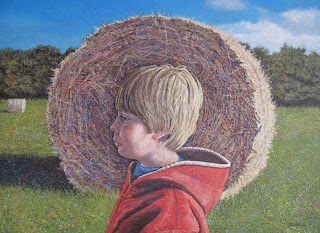Learning to leave
 |
| Boy with Hay Bale, oil on canvas, 27"x37", Steven Rhude |
The search for community is a creative process of constructing what Castells calls 'resistance identities' which oppose the 'legitimized identities' constructed for us in the context of civil society and its state apparatuses.'
Michael Corbett - Learning to Leave, The Irony of Schooling in a Coastal Community, Fernwood Publishing
The guest analyst referred to the region as 'a resource based, industrial life style driven into the ground.' A world of clear cuts and Monsanto. But the boy recalled his Dad saying otherwise. Something like a tangled and interwoven world of layers stood out in his memory.
Starting from scratch - wind, seed, and all compressed into an image of iconic growth.
That romantic folk legend said something about how he 'gave it up and went to town'. But that wasn't on his mind as a child. In fact learning to leave was furthest from his mind.
He loved to hear them referred to as Tootsie Rolls in a Field. Delighted in the fact he conjured a metaphor expressing the sweetness of shape and design - something to be consumed. But really it was just hay - or long rows of sun and community, baled into a shape universal. Unfettered like a sewer lid incongruent - yet fitting and essential to any city street.
However, boys dream and drift. So he thought of Andrew Wyeth - temperas made of eggs, earth, ochre and umber. How could anything be more rural or exacting?
The boy thought of isolation and that string bean called Hopper. Comfortable being alone in the woods; confronted suddenly with the image of urban anxiety. For the boy, the field was his Office in a Small City. His ground of being.
That compression thing again. Like making a snow ball packed tightly.
More plant closures - Bowater Mersey, transition teams, and foreign buyers in the wings...
Time to cut the bales open and unravel their humanity and contents. Lay it out like a carpet of revitalization for them.
Steven Rhude, Wolfville, NS


This piece harmonizes with me well. I grew up as a child living on old farming ground; a barn, who is now in retirement, which is somewhere in the vicinity of 160 years of age, stands silently next to my home. There used to be a bustling amount of farm-life on my family's little plot of land, but by the time I was born, the numbers of livestock had been reduced to just two horses, and then in recent years to none. What was once a way of life became a hobby, then a rarity, and next (to what some people would go even as far as to call) a hindrance.
ReplyDeleteYes, it is a shame... but it is just 'a sign of the times' Or so they would have you think.
Nonetheless, I love my grey and faded barn. I believe it to be a centerpiece; a monument of our community's past! Heritage from home, you know?
_________
I love your painting and I like how the broadside of the round bale is centered behind the boy like a halo. It makes him look Christ- or saint-like, accentuating the innocents of childhood. It hints at an alluring desire that some people have to return to this forgotten way of life.
-Lenney, age 17, NB.
Thanks Len. Your comments are very thoughtful and connect perfectly with the objective of this painting! I've wanted to do this work for a long time but never seemed to get around to it until this year. Listening to people on the radio discuss the state of our rural areas finally provoked it I guess. Your barn sounds great!
ReplyDeleteJust another example of your sensitivity and uncanny ability to see what eludes so many others.
ReplyDeleteThank you for sharing your work with us.